Actions Taken by Governments and Organizations in Protecting the Environment
VerifiedAdded on 2023/06/10
|7
|1764
|190
AI Summary
This essay discusses the failure of actions taken by governments and organizations in protecting the environment. It highlights the reasons behind the failure of sustainable environment initiatives and provides examples of government policies that have failed the environment. The essay concludes by emphasizing the need for thoughtful solutions to minimize environmental pollution.
Contribute Materials
Your contribution can guide someone’s learning journey. Share your
documents today.
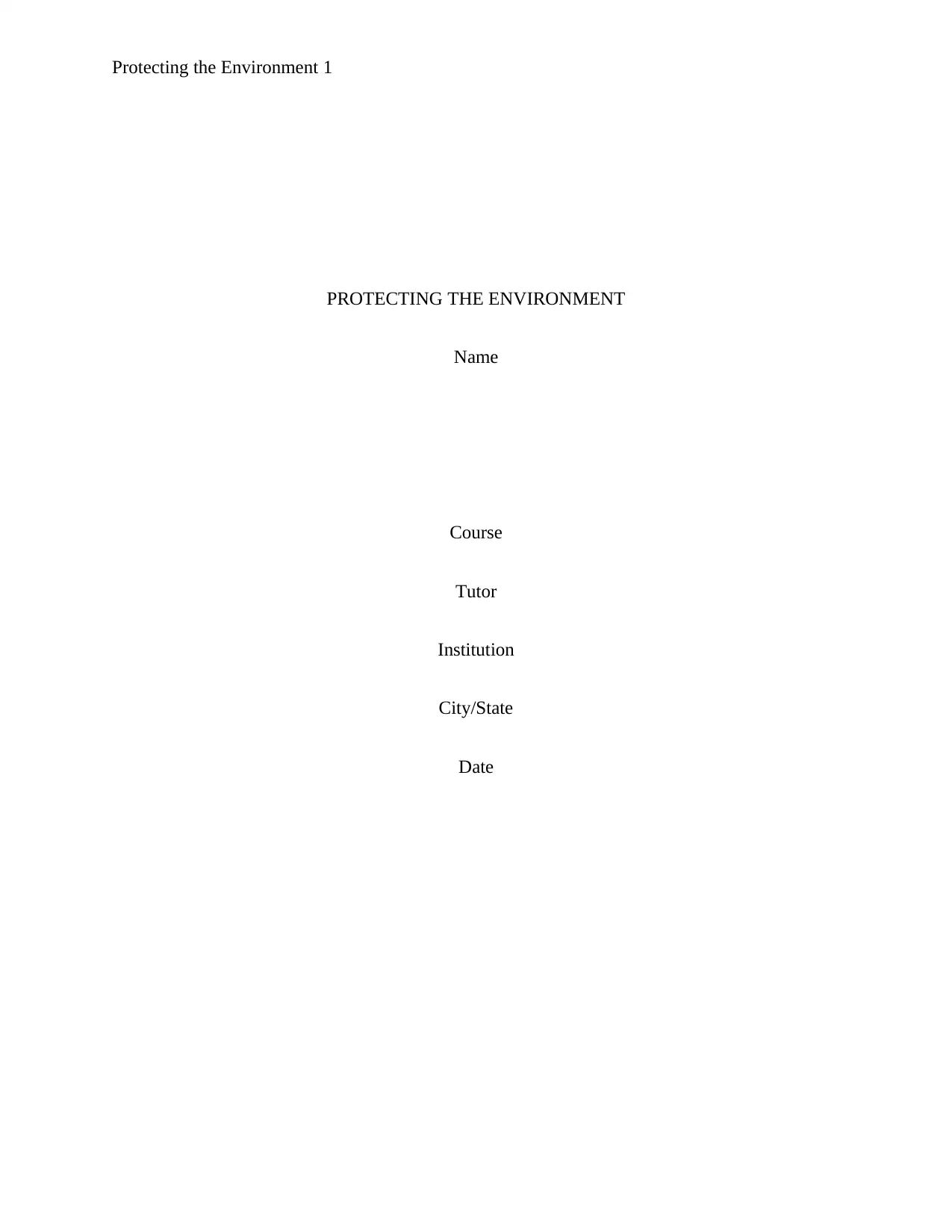
Protecting the Environment 1
PROTECTING THE ENVIRONMENT
Name
Course
Tutor
Institution
City/State
Date
PROTECTING THE ENVIRONMENT
Name
Course
Tutor
Institution
City/State
Date
Secure Best Marks with AI Grader
Need help grading? Try our AI Grader for instant feedback on your assignments.
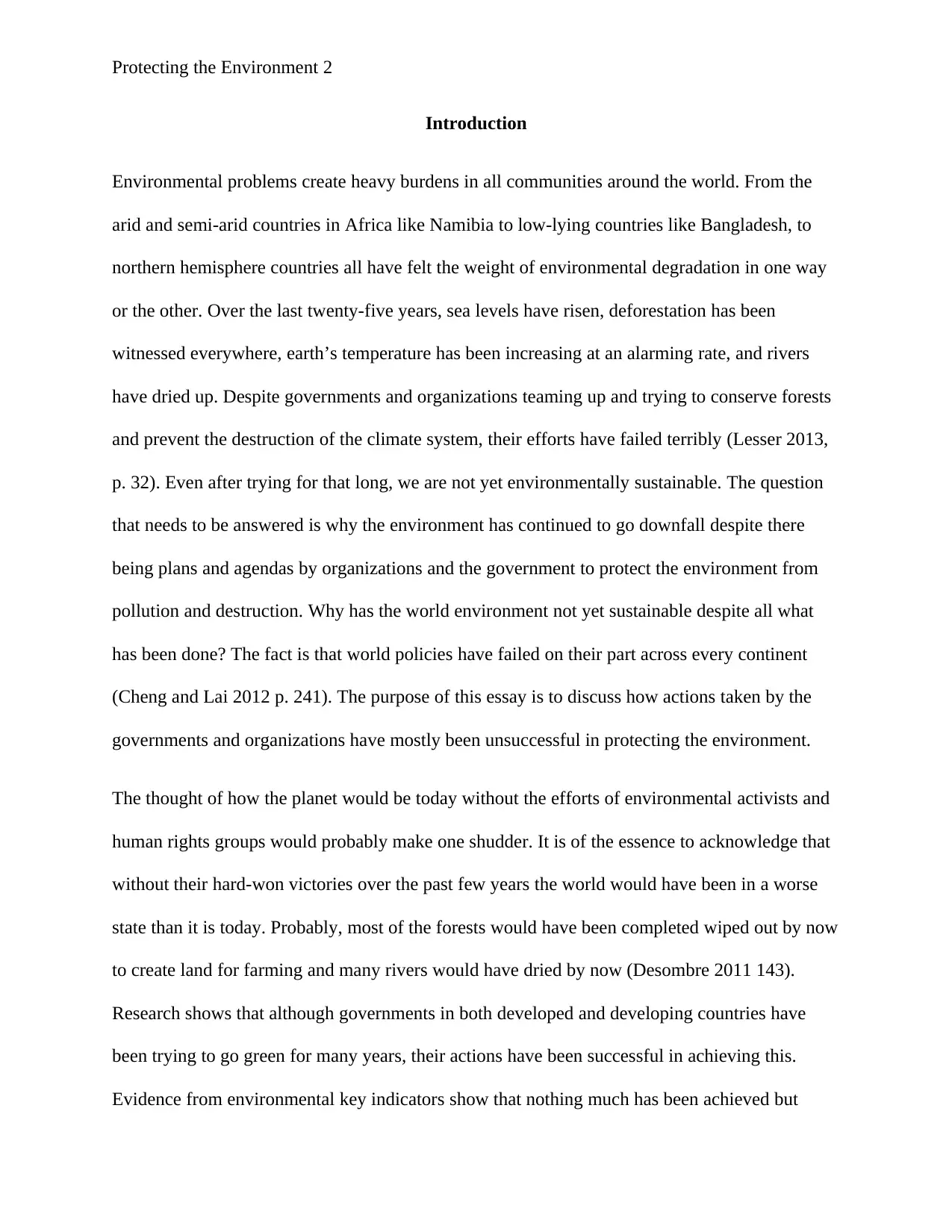
Protecting the Environment 2
Introduction
Environmental problems create heavy burdens in all communities around the world. From the
arid and semi-arid countries in Africa like Namibia to low-lying countries like Bangladesh, to
northern hemisphere countries all have felt the weight of environmental degradation in one way
or the other. Over the last twenty-five years, sea levels have risen, deforestation has been
witnessed everywhere, earth’s temperature has been increasing at an alarming rate, and rivers
have dried up. Despite governments and organizations teaming up and trying to conserve forests
and prevent the destruction of the climate system, their efforts have failed terribly (Lesser 2013,
p. 32). Even after trying for that long, we are not yet environmentally sustainable. The question
that needs to be answered is why the environment has continued to go downfall despite there
being plans and agendas by organizations and the government to protect the environment from
pollution and destruction. Why has the world environment not yet sustainable despite all what
has been done? The fact is that world policies have failed on their part across every continent
(Cheng and Lai 2012 p. 241). The purpose of this essay is to discuss how actions taken by the
governments and organizations have mostly been unsuccessful in protecting the environment.
The thought of how the planet would be today without the efforts of environmental activists and
human rights groups would probably make one shudder. It is of the essence to acknowledge that
without their hard-won victories over the past few years the world would have been in a worse
state than it is today. Probably, most of the forests would have been completed wiped out by now
to create land for farming and many rivers would have dried by now (Desombre 2011 143).
Research shows that although governments in both developed and developing countries have
been trying to go green for many years, their actions have been successful in achieving this.
Evidence from environmental key indicators show that nothing much has been achieved but
Introduction
Environmental problems create heavy burdens in all communities around the world. From the
arid and semi-arid countries in Africa like Namibia to low-lying countries like Bangladesh, to
northern hemisphere countries all have felt the weight of environmental degradation in one way
or the other. Over the last twenty-five years, sea levels have risen, deforestation has been
witnessed everywhere, earth’s temperature has been increasing at an alarming rate, and rivers
have dried up. Despite governments and organizations teaming up and trying to conserve forests
and prevent the destruction of the climate system, their efforts have failed terribly (Lesser 2013,
p. 32). Even after trying for that long, we are not yet environmentally sustainable. The question
that needs to be answered is why the environment has continued to go downfall despite there
being plans and agendas by organizations and the government to protect the environment from
pollution and destruction. Why has the world environment not yet sustainable despite all what
has been done? The fact is that world policies have failed on their part across every continent
(Cheng and Lai 2012 p. 241). The purpose of this essay is to discuss how actions taken by the
governments and organizations have mostly been unsuccessful in protecting the environment.
The thought of how the planet would be today without the efforts of environmental activists and
human rights groups would probably make one shudder. It is of the essence to acknowledge that
without their hard-won victories over the past few years the world would have been in a worse
state than it is today. Probably, most of the forests would have been completed wiped out by now
to create land for farming and many rivers would have dried by now (Desombre 2011 143).
Research shows that although governments in both developed and developing countries have
been trying to go green for many years, their actions have been successful in achieving this.
Evidence from environmental key indicators show that nothing much has been achieved but
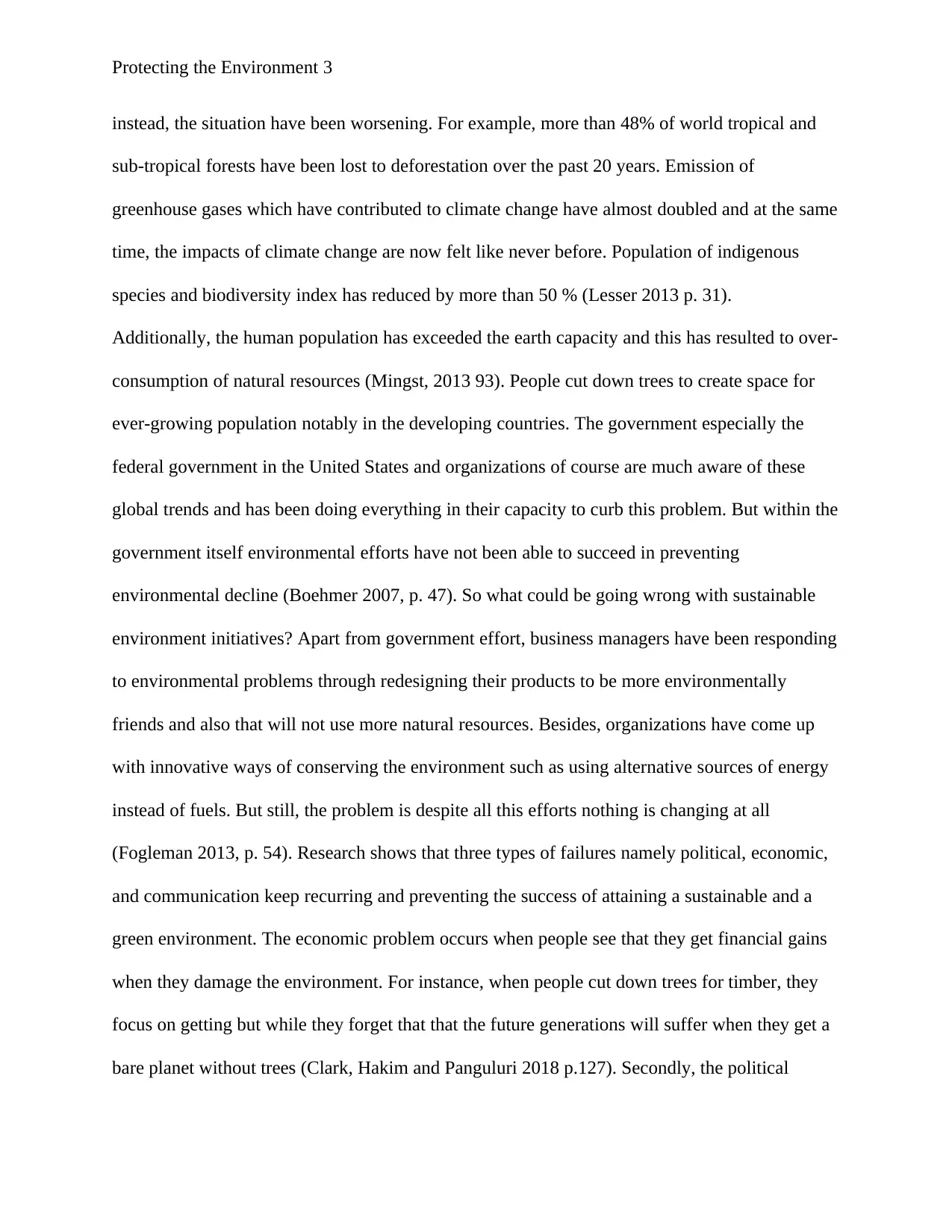
Protecting the Environment 3
instead, the situation have been worsening. For example, more than 48% of world tropical and
sub-tropical forests have been lost to deforestation over the past 20 years. Emission of
greenhouse gases which have contributed to climate change have almost doubled and at the same
time, the impacts of climate change are now felt like never before. Population of indigenous
species and biodiversity index has reduced by more than 50 % (Lesser 2013 p. 31).
Additionally, the human population has exceeded the earth capacity and this has resulted to over-
consumption of natural resources (Mingst, 2013 93). People cut down trees to create space for
ever-growing population notably in the developing countries. The government especially the
federal government in the United States and organizations of course are much aware of these
global trends and has been doing everything in their capacity to curb this problem. But within the
government itself environmental efforts have not been able to succeed in preventing
environmental decline (Boehmer 2007, p. 47). So what could be going wrong with sustainable
environment initiatives? Apart from government effort, business managers have been responding
to environmental problems through redesigning their products to be more environmentally
friends and also that will not use more natural resources. Besides, organizations have come up
with innovative ways of conserving the environment such as using alternative sources of energy
instead of fuels. But still, the problem is despite all this efforts nothing is changing at all
(Fogleman 2013, p. 54). Research shows that three types of failures namely political, economic,
and communication keep recurring and preventing the success of attaining a sustainable and a
green environment. The economic problem occurs when people see that they get financial gains
when they damage the environment. For instance, when people cut down trees for timber, they
focus on getting but while they forget that that the future generations will suffer when they get a
bare planet without trees (Clark, Hakim and Panguluri 2018 p.127). Secondly, the political
instead, the situation have been worsening. For example, more than 48% of world tropical and
sub-tropical forests have been lost to deforestation over the past 20 years. Emission of
greenhouse gases which have contributed to climate change have almost doubled and at the same
time, the impacts of climate change are now felt like never before. Population of indigenous
species and biodiversity index has reduced by more than 50 % (Lesser 2013 p. 31).
Additionally, the human population has exceeded the earth capacity and this has resulted to over-
consumption of natural resources (Mingst, 2013 93). People cut down trees to create space for
ever-growing population notably in the developing countries. The government especially the
federal government in the United States and organizations of course are much aware of these
global trends and has been doing everything in their capacity to curb this problem. But within the
government itself environmental efforts have not been able to succeed in preventing
environmental decline (Boehmer 2007, p. 47). So what could be going wrong with sustainable
environment initiatives? Apart from government effort, business managers have been responding
to environmental problems through redesigning their products to be more environmentally
friends and also that will not use more natural resources. Besides, organizations have come up
with innovative ways of conserving the environment such as using alternative sources of energy
instead of fuels. But still, the problem is despite all this efforts nothing is changing at all
(Fogleman 2013, p. 54). Research shows that three types of failures namely political, economic,
and communication keep recurring and preventing the success of attaining a sustainable and a
green environment. The economic problem occurs when people see that they get financial gains
when they damage the environment. For instance, when people cut down trees for timber, they
focus on getting but while they forget that that the future generations will suffer when they get a
bare planet without trees (Clark, Hakim and Panguluri 2018 p.127). Secondly, the political
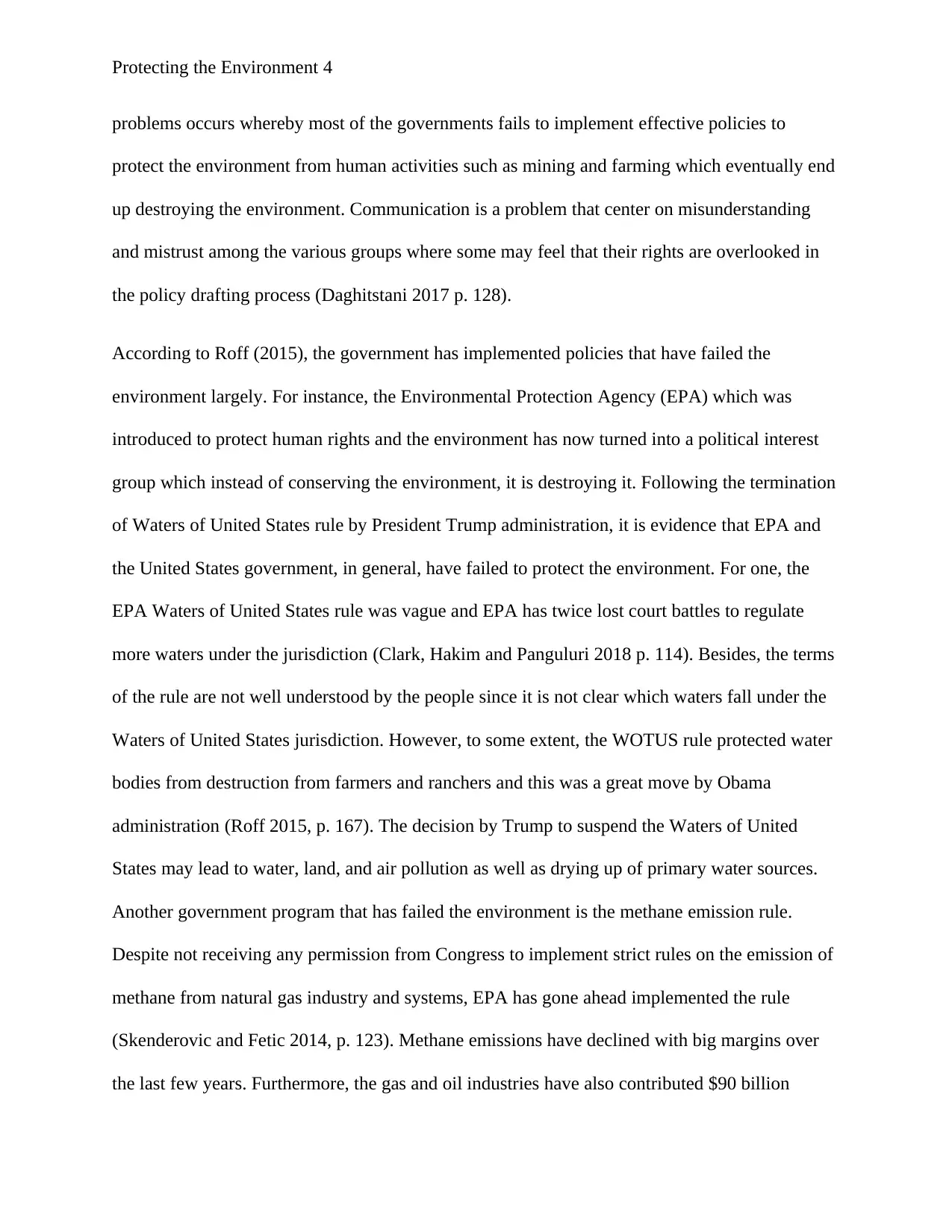
Protecting the Environment 4
problems occurs whereby most of the governments fails to implement effective policies to
protect the environment from human activities such as mining and farming which eventually end
up destroying the environment. Communication is a problem that center on misunderstanding
and mistrust among the various groups where some may feel that their rights are overlooked in
the policy drafting process (Daghitstani 2017 p. 128).
According to Roff (2015), the government has implemented policies that have failed the
environment largely. For instance, the Environmental Protection Agency (EPA) which was
introduced to protect human rights and the environment has now turned into a political interest
group which instead of conserving the environment, it is destroying it. Following the termination
of Waters of United States rule by President Trump administration, it is evidence that EPA and
the United States government, in general, have failed to protect the environment. For one, the
EPA Waters of United States rule was vague and EPA has twice lost court battles to regulate
more waters under the jurisdiction (Clark, Hakim and Panguluri 2018 p. 114). Besides, the terms
of the rule are not well understood by the people since it is not clear which waters fall under the
Waters of United States jurisdiction. However, to some extent, the WOTUS rule protected water
bodies from destruction from farmers and ranchers and this was a great move by Obama
administration (Roff 2015, p. 167). The decision by Trump to suspend the Waters of United
States may lead to water, land, and air pollution as well as drying up of primary water sources.
Another government program that has failed the environment is the methane emission rule.
Despite not receiving any permission from Congress to implement strict rules on the emission of
methane from natural gas industry and systems, EPA has gone ahead implemented the rule
(Skenderovic and Fetic 2014, p. 123). Methane emissions have declined with big margins over
the last few years. Furthermore, the gas and oil industries have also contributed $90 billion
problems occurs whereby most of the governments fails to implement effective policies to
protect the environment from human activities such as mining and farming which eventually end
up destroying the environment. Communication is a problem that center on misunderstanding
and mistrust among the various groups where some may feel that their rights are overlooked in
the policy drafting process (Daghitstani 2017 p. 128).
According to Roff (2015), the government has implemented policies that have failed the
environment largely. For instance, the Environmental Protection Agency (EPA) which was
introduced to protect human rights and the environment has now turned into a political interest
group which instead of conserving the environment, it is destroying it. Following the termination
of Waters of United States rule by President Trump administration, it is evidence that EPA and
the United States government, in general, have failed to protect the environment. For one, the
EPA Waters of United States rule was vague and EPA has twice lost court battles to regulate
more waters under the jurisdiction (Clark, Hakim and Panguluri 2018 p. 114). Besides, the terms
of the rule are not well understood by the people since it is not clear which waters fall under the
Waters of United States jurisdiction. However, to some extent, the WOTUS rule protected water
bodies from destruction from farmers and ranchers and this was a great move by Obama
administration (Roff 2015, p. 167). The decision by Trump to suspend the Waters of United
States may lead to water, land, and air pollution as well as drying up of primary water sources.
Another government program that has failed the environment is the methane emission rule.
Despite not receiving any permission from Congress to implement strict rules on the emission of
methane from natural gas industry and systems, EPA has gone ahead implemented the rule
(Skenderovic and Fetic 2014, p. 123). Methane emissions have declined with big margins over
the last few years. Furthermore, the gas and oil industries have also contributed $90 billion
Secure Best Marks with AI Grader
Need help grading? Try our AI Grader for instant feedback on your assignments.
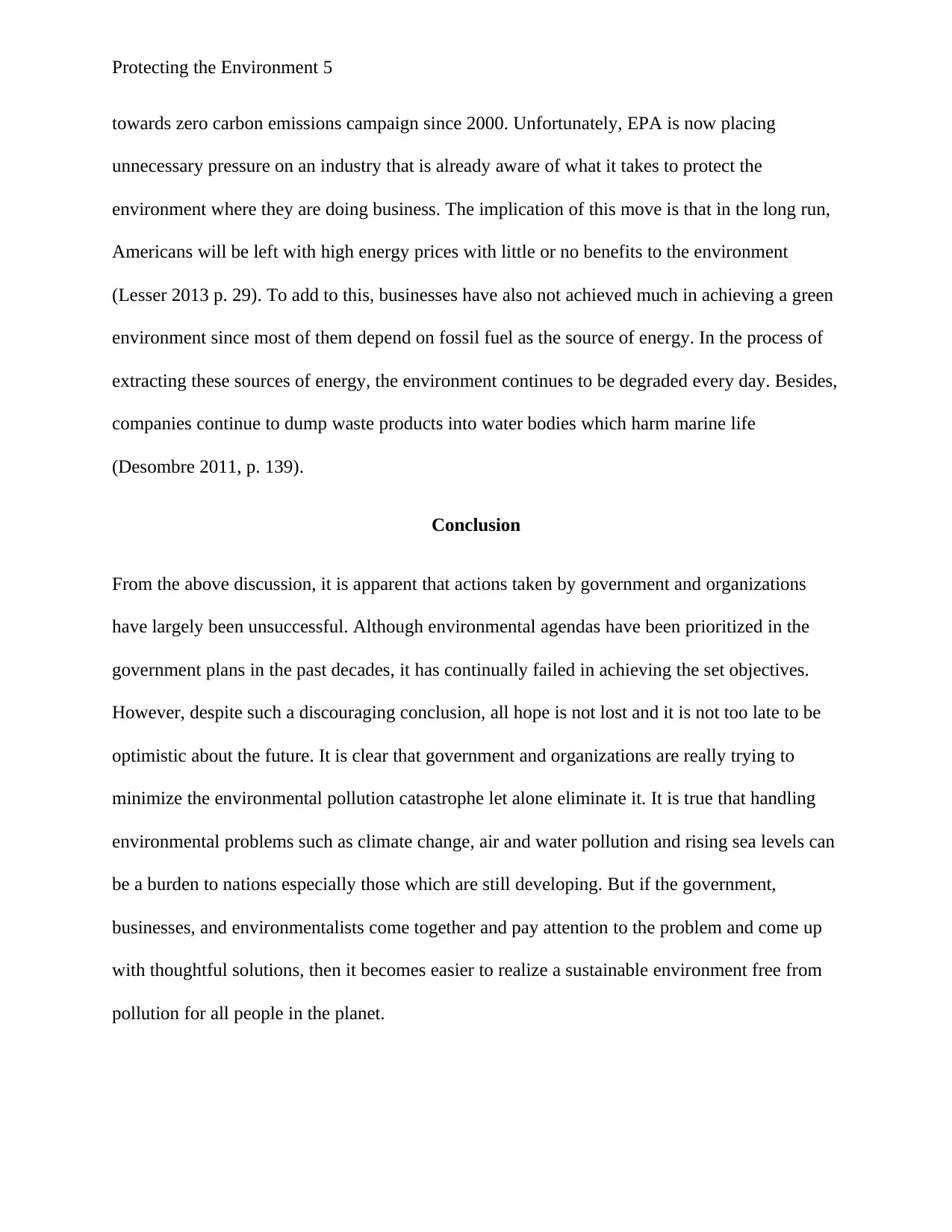
Protecting the Environment 5
towards zero carbon emissions campaign since 2000. Unfortunately, EPA is now placing
unnecessary pressure on an industry that is already aware of what it takes to protect the
environment where they are doing business. The implication of this move is that in the long run,
Americans will be left with high energy prices with little or no benefits to the environment
(Lesser 2013 p. 29). To add to this, businesses have also not achieved much in achieving a green
environment since most of them depend on fossil fuel as the source of energy. In the process of
extracting these sources of energy, the environment continues to be degraded every day. Besides,
companies continue to dump waste products into water bodies which harm marine life
(Desombre 2011, p. 139).
Conclusion
From the above discussion, it is apparent that actions taken by government and organizations
have largely been unsuccessful. Although environmental agendas have been prioritized in the
government plans in the past decades, it has continually failed in achieving the set objectives.
However, despite such a discouraging conclusion, all hope is not lost and it is not too late to be
optimistic about the future. It is clear that government and organizations are really trying to
minimize the environmental pollution catastrophe let alone eliminate it. It is true that handling
environmental problems such as climate change, air and water pollution and rising sea levels can
be a burden to nations especially those which are still developing. But if the government,
businesses, and environmentalists come together and pay attention to the problem and come up
with thoughtful solutions, then it becomes easier to realize a sustainable environment free from
pollution for all people in the planet.
towards zero carbon emissions campaign since 2000. Unfortunately, EPA is now placing
unnecessary pressure on an industry that is already aware of what it takes to protect the
environment where they are doing business. The implication of this move is that in the long run,
Americans will be left with high energy prices with little or no benefits to the environment
(Lesser 2013 p. 29). To add to this, businesses have also not achieved much in achieving a green
environment since most of them depend on fossil fuel as the source of energy. In the process of
extracting these sources of energy, the environment continues to be degraded every day. Besides,
companies continue to dump waste products into water bodies which harm marine life
(Desombre 2011, p. 139).
Conclusion
From the above discussion, it is apparent that actions taken by government and organizations
have largely been unsuccessful. Although environmental agendas have been prioritized in the
government plans in the past decades, it has continually failed in achieving the set objectives.
However, despite such a discouraging conclusion, all hope is not lost and it is not too late to be
optimistic about the future. It is clear that government and organizations are really trying to
minimize the environmental pollution catastrophe let alone eliminate it. It is true that handling
environmental problems such as climate change, air and water pollution and rising sea levels can
be a burden to nations especially those which are still developing. But if the government,
businesses, and environmentalists come together and pay attention to the problem and come up
with thoughtful solutions, then it becomes easier to realize a sustainable environment free from
pollution for all people in the planet.
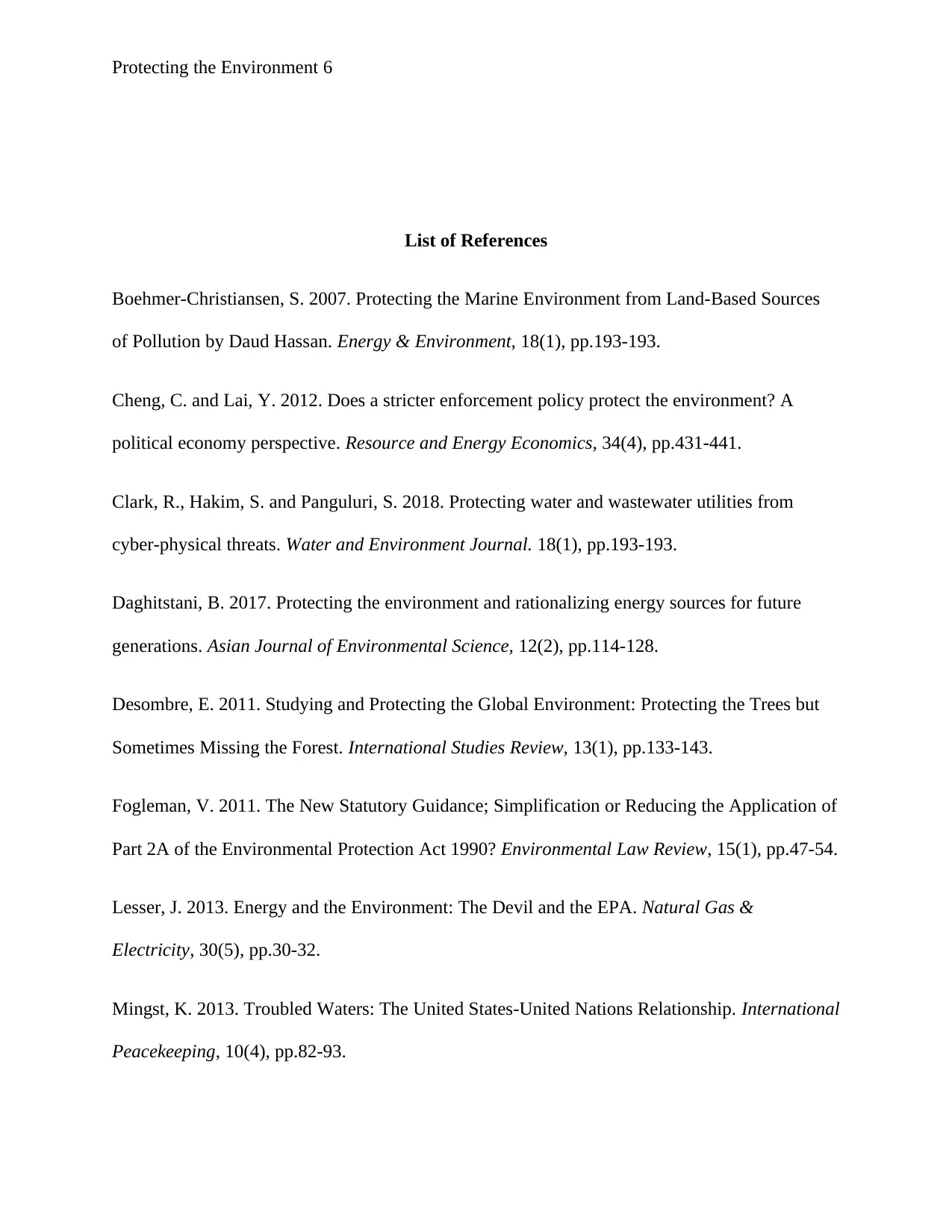
Protecting the Environment 6
List of References
Boehmer-Christiansen, S. 2007. Protecting the Marine Environment from Land-Based Sources
of Pollution by Daud Hassan. Energy & Environment, 18(1), pp.193-193.
Cheng, C. and Lai, Y. 2012. Does a stricter enforcement policy protect the environment? A
political economy perspective. Resource and Energy Economics, 34(4), pp.431-441.
Clark, R., Hakim, S. and Panguluri, S. 2018. Protecting water and wastewater utilities from
cyber-physical threats. Water and Environment Journal. 18(1), pp.193-193.
Daghitstani, B. 2017. Protecting the environment and rationalizing energy sources for future
generations. Asian Journal of Environmental Science, 12(2), pp.114-128.
Desombre, E. 2011. Studying and Protecting the Global Environment: Protecting the Trees but
Sometimes Missing the Forest. International Studies Review, 13(1), pp.133-143.
Fogleman, V. 2011. The New Statutory Guidance; Simplification or Reducing the Application of
Part 2A of the Environmental Protection Act 1990? Environmental Law Review, 15(1), pp.47-54.
Lesser, J. 2013. Energy and the Environment: The Devil and the EPA. Natural Gas &
Electricity, 30(5), pp.30-32.
Mingst, K. 2013. Troubled Waters: The United States-United Nations Relationship. International
Peacekeeping, 10(4), pp.82-93.
List of References
Boehmer-Christiansen, S. 2007. Protecting the Marine Environment from Land-Based Sources
of Pollution by Daud Hassan. Energy & Environment, 18(1), pp.193-193.
Cheng, C. and Lai, Y. 2012. Does a stricter enforcement policy protect the environment? A
political economy perspective. Resource and Energy Economics, 34(4), pp.431-441.
Clark, R., Hakim, S. and Panguluri, S. 2018. Protecting water and wastewater utilities from
cyber-physical threats. Water and Environment Journal. 18(1), pp.193-193.
Daghitstani, B. 2017. Protecting the environment and rationalizing energy sources for future
generations. Asian Journal of Environmental Science, 12(2), pp.114-128.
Desombre, E. 2011. Studying and Protecting the Global Environment: Protecting the Trees but
Sometimes Missing the Forest. International Studies Review, 13(1), pp.133-143.
Fogleman, V. 2011. The New Statutory Guidance; Simplification or Reducing the Application of
Part 2A of the Environmental Protection Act 1990? Environmental Law Review, 15(1), pp.47-54.
Lesser, J. 2013. Energy and the Environment: The Devil and the EPA. Natural Gas &
Electricity, 30(5), pp.30-32.
Mingst, K. 2013. Troubled Waters: The United States-United Nations Relationship. International
Peacekeeping, 10(4), pp.82-93.
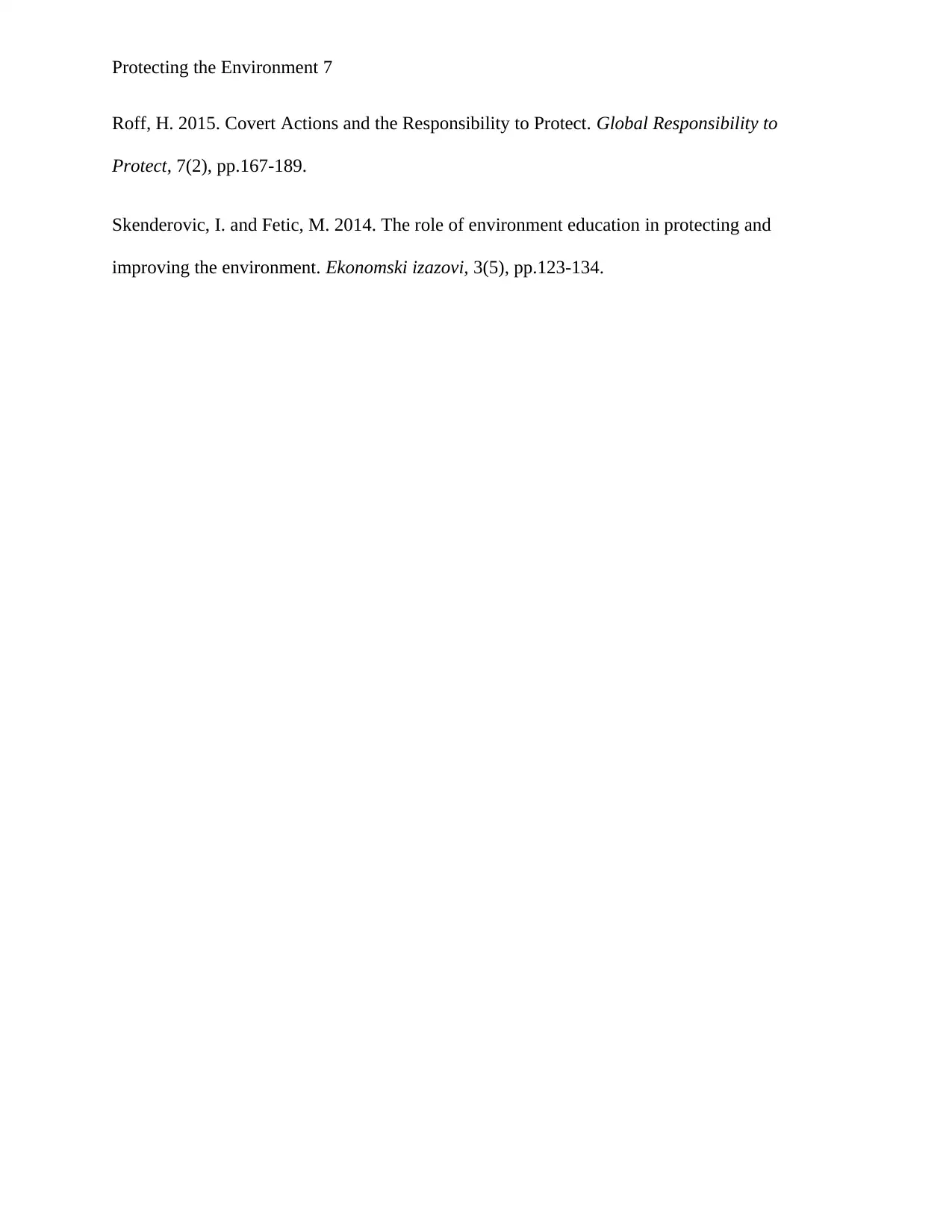
Protecting the Environment 7
Roff, H. 2015. Covert Actions and the Responsibility to Protect. Global Responsibility to
Protect, 7(2), pp.167-189.
Skenderovic, I. and Fetic, M. 2014. The role of environment education in protecting and
improving the environment. Ekonomski izazovi, 3(5), pp.123-134.
Roff, H. 2015. Covert Actions and the Responsibility to Protect. Global Responsibility to
Protect, 7(2), pp.167-189.
Skenderovic, I. and Fetic, M. 2014. The role of environment education in protecting and
improving the environment. Ekonomski izazovi, 3(5), pp.123-134.
1 out of 7
Related Documents
Your All-in-One AI-Powered Toolkit for Academic Success.
+13062052269
info@desklib.com
Available 24*7 on WhatsApp / Email
![[object Object]](/_next/static/media/star-bottom.7253800d.svg)
Unlock your academic potential
© 2024 | Zucol Services PVT LTD | All rights reserved.





